The Event-Carried State Transfer (ECST) Pattern
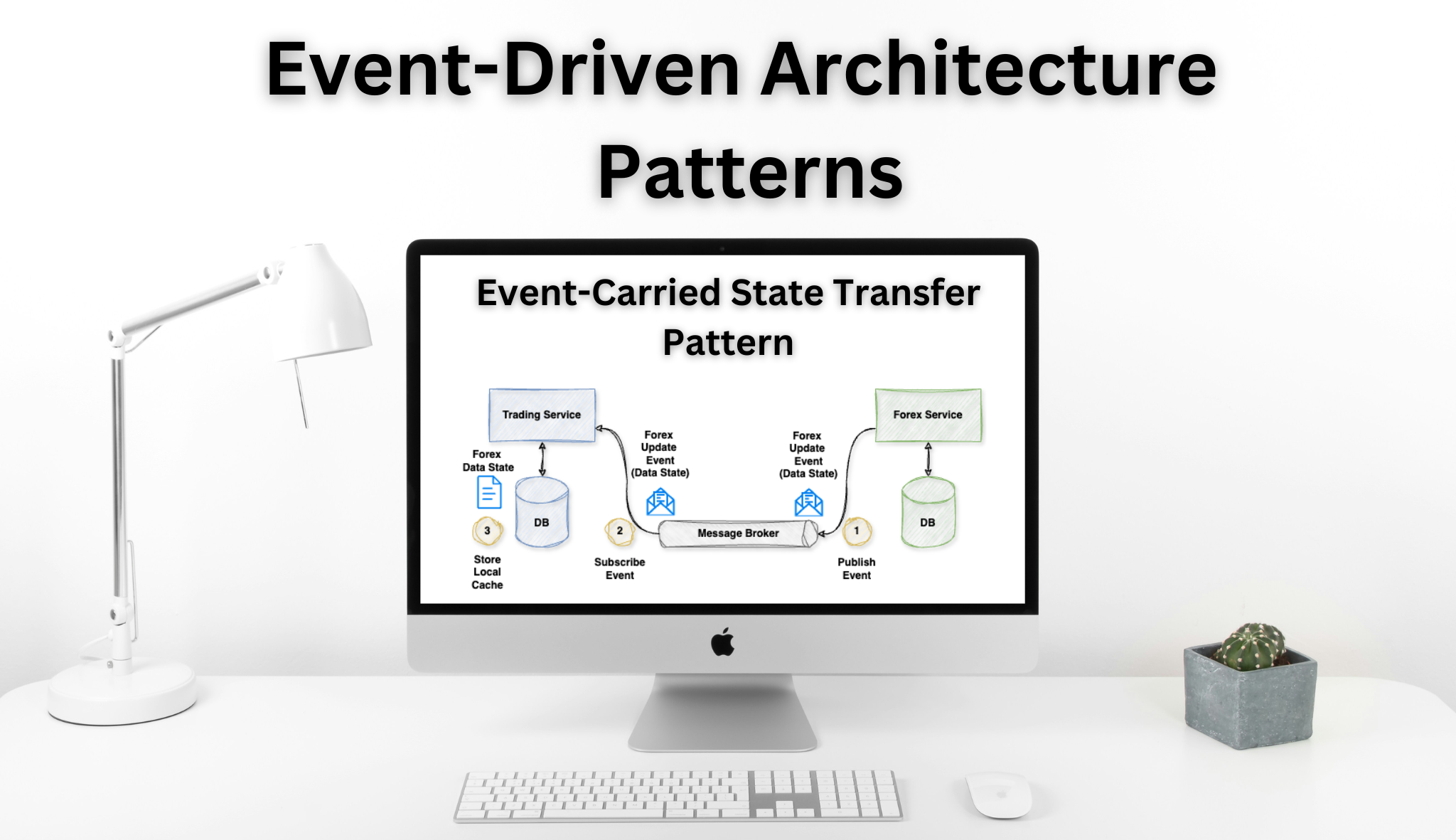
A Comprehensive Guide to Understanding the Event-Carried State Transfer Pattern
- What is the ECST Pattern?
- Key Concepts of ECST Pattern
- Benefits of ECST Pattern
- Challenges of ECST Pattern
- Use Cases for ECST Pattern
- Explanation of the ECST Pattern
- Key Points
- Conclusion
The Event-Carried State Transfer (ECST) pattern is a powerful approach within Event-Driven Architecture, where events not only signal changes but also carry all the necessary state information.
This allows services to update their local state independently without needing to make synchronous calls to other services.
This post provides a comprehensive guide to the Event-Carried State Transfer (ECST) pattern, covering its key concepts, benefits, challenges, use cases, and practical examples, with a focus on its application in a currency exchange platform.
What is the ECST Pattern?
The Event-Carried State Transfer (ECST) pattern in Event-Driven Architecture is a design approach where events signal the occurrence of something and carry the necessary state information with them.
Each event is self-sufficient, containing enough data to allow other services to process it independently, without needing to make additional requests to retrieve state from other systems.
ECST enhances service decoupling, as services can react to events immediately using the information provided by the event itself.
Avoid synchronous blocking calls between services, thereby preventing temporal coupling and ensuring continuous availability.
This pattern is useful in distributed systems where minimising dependencies and communication overhead is crucial for performance and resilience.
Key Concepts of ECST Pattern
The key concepts of the Event-Carried State Transfer (ECST) pattern are:
- Event-Driven Architecture: ECST operates within an event-driven architecture, where events represent changes or significant occurrences within the system. Services communicate by producing and consuming these events, enabling asynchronous interactions and reducing direct dependencies between services.
- State Propagation: In ECST, state updates are propagated through events rather than synchronous calls. Each event carries the necessary state changes, allowing services to independently update their local state based on the events they receive. This promotes asynchronous communication and service autonomy.
- Event: An event in ECST is a message that signifies a change in state or an important occurrence. It includes all the necessary data for other services to update their state, ensuring that each service can act on the event without needing additional context or information from other services.
- State Transfer: The state transfer concept in ECST means that events carry the new state or the delta (change) required to bring a consuming service’s state in sync with the state of the producing service. This mechanism ensures that all relevant services are consistently updated with the latest state.
Benefits of ECST Pattern
The Event-Carried State Transfer (ECST) pattern offers several key benefits for systems built on event-driven architecture:
- Reduced Coupling: ECST enables services to be decoupled, as they communicate asynchronously through events. This allows services to be developed, deployed, and scaled independently without tight dependencies on one another.
- Scalability: By avoiding synchronous calls that can become bottlenecks, ECST allows systems to scale more efficiently. Services can process events at their own pace, enabling the system to handle high volumes of events and adapt to increased demand.
- Resilience: ECST enhances system resilience by enabling services to operate independently and update their state based on events. This reduces the risk of cascading failures, as services do not rely on the availability of other services for real-time state information.
- Real-time Updates: Consumers can react to events in real-time, ensuring their state is always up-to-date. This eliminates the need for polling or querying other services, leading to more efficient and responsive systems.
- Consistent System State: ECST ensures that all services maintain a consistent view of the system’s state by propagating events with the necessary state information. This is especially beneficial in distributed systems, where maintaining consistency across services can be complex.
Challenges of ECST Pattern
The Event Carried State Transfer (ECST) pattern presents several challenges:
- Event Size: Events can become large if they carry a lot of state information, potentially impacting performance. This increase in event size can also strain the message broker and network infrastructure.
- Data Consistency: Ensuring eventual consistency across services can be complex, especially when dealing with network partitions or failures.
- Event Ordering: Consumers need to handle events that may arrive out of order. Duplicate events needs to be removed by the consumer.
- Schema Evolution: Managing changes to the event schema can be challenging as the state structure evolves. Ensuring backward compatibility and handling versioning are critical to prevent breaking existing consumers.
- Security and Privacy Concerns: Carrying complete state information in events can expose sensitive data if not adequately secured, raising concerns about data privacy and the need for robust security measures in event handling and transmission.
- Complexity in Consumer Logic: Consumers need to implement more complex logic to handle events, mainly when dealing with partial updates, merging states, or resolving conflicts that arise from concurrent events.
Use Cases for ECST Pattern
The Event Carried State Transfer (ECST) pattern has several use cases:
- Microservices Architecture: ECST is particularly useful in microservices architectures where services need to maintain their own state without tightly coupling to other services.
- Event Sourcing: In systems using event sourcing, ECST can be used to propagate state changes across different services.
- Distributed Systems: In distributed systems where services are spread across different nodes or regions, ECST helps maintain consistency without direct communication.
Explanation of the ECST Pattern
Scenario
There are two services in the currency exchange platform called the Forex Service and the Trading Service.
- Forex Service is responsible for fetching and maintaining the latest exchange rates for various currency pairs, such as EUR/USD.
- Trading Service needs the most up-to-date exchange rates to execute trades accurately. The challenge arises when the Trading Service requires the latest exchange rate data from the Forex Service to make informed trading decisions.
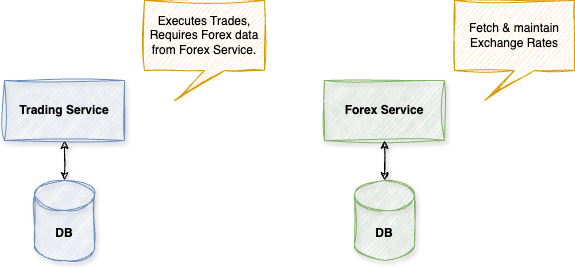
If the Trading Service relies on constantly querying the Forex Service for updated rates, this setup can lead to inefficiencies, increased load, and potential delays.
Temporal Coupling
If the Trading Service used synchronous requests to retrieve the latest exchange rates from the Forex Service each time it needed to execute a trade, this would introduce temporal coupling between the two services.
Temporal coupling means that the Trading Service depends on the Forex Service’s availability and response time.
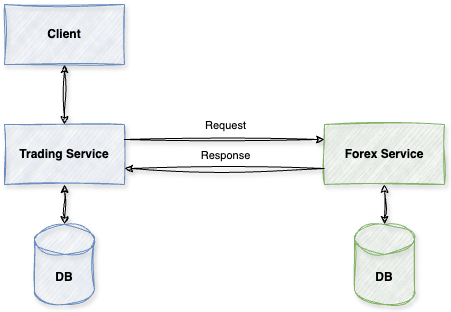
Suppose the Forex Service experiences downtime or latency issues or cannot respond promptly. In that case, the Trading Service will be blocked, leading to potential delays in executing trades, loss of opportunities, or even system failures.
This tight dependency makes the overall system more fragile and less resilient to failures, reducing its reliability and scalability.
Notification and Local Cache
The Trading Service needs access to the latest exchange rates the Forex Service provides.
The Trading Service maintains a local cache of the forex data within its database to avoid reliance on synchronous, blocking calls.
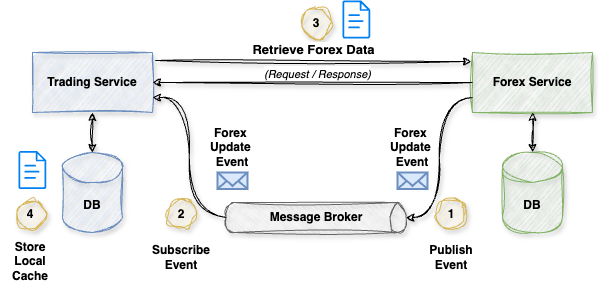
A notification-based approach can help achieve this. The Forex Service publishes an event whenever there is an exchange rate update, and the Trading Service subscribes to these events.
Upon receiving a notification, the Trading Service retrieves the updated rate from the Forex Service and updates its local cache, ensuring it can operate independently.
The following is an example of the ForexRateUpdated event as part of the Notification solution:
{
"eventId": "67890-xyz123-abc456-mnop789",
"eventType": "ForexRateUpdated",
"version": "1.0",
"timestamp": "2024-08-09T10:15:30.456Z",
"source": "ForexService",
}
Challenges:
- Increased Load: Frequent updates may require numerous calls back to the Forex Service, increasing its load.
- Availability Concerns: If the Forex Service is unavailable, the Trading Service may operate with stale data until the latest information can be retrieved.
Event-Carried State Transfer Pattern
In the Event-Carried State Transfer (ECST) pattern, events do more than notify other services that something has changed; they contain the entire state of the entity involved in the change.
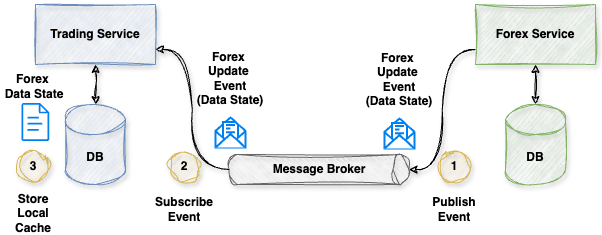
This means that when the Forex Service updates an exchange rate, it includes all the relevant details of that update in the event it publishes.
When the Trading Service receives this event, it can immediately update its local cache without making a synchronous call back to the Forex Service.
The following is an example of the ForexRateUpdated event as part of the Event-Carried State Transfer pattern:
{
"eventId": "67890-xyz123-abc456-mnop789",
"eventType": "ForexRateUpdated",
"version": "1.0",
"timestamp": "2024-08-09T10:15:30.456Z",
"source": "ForexService",
"forexDetails": {
"currencyPair": "EUR/USD",
"newRate": 1.1050,
"previousRate": 1.1034,
"changePercent": 0.14,
"rateTimestamp": "2024-08-09T10:15:00.000Z"
}
}
Key Points
The key points of the Event-Carrier State Transfer Pattern is:
- Immutable Data: The data included in the event is from another service’s boundary and is treated as read-only by the receiving service (Trading Service). This data is a snapshot of the state at the time of the change and cannot be altered by the consuming service.
- Assume Staleness: Although the Trading Service updates its local cache with the data from the event, there is always a possibility that the data might be slightly outdated. The service must understand this potential staleness and handle it appropriately.
- Versioning: To manage concurrent processing and ensure the most accurate and fresh data is used, events should be versioned. This helps the Trading Service keep its local cache up-to-date and consistent with the latest information from the Forex Service.
- No Callbacks Needed: Since the event contains all necessary data, the Trading Service does not need to make a call back to the Forex Service, reducing dependency and improving performance.
Conclusion
The Event-Carried State Transfer (ECST) pattern is a crucial tool in modern event-driven architectures.
It enables services to operate independently and efficiently by embedding state information directly within events.
By adopting ECST, systems can achieve greater scalability, resilience, and reduced dependency, making them better suited for complex, distributed environments.
